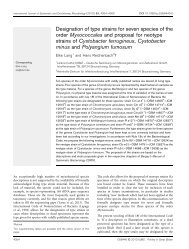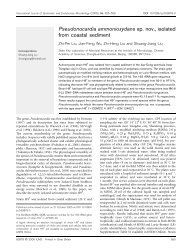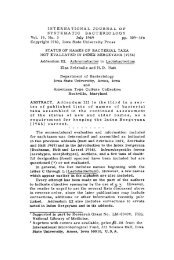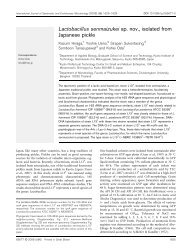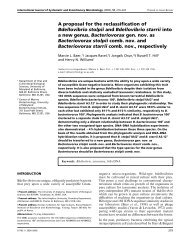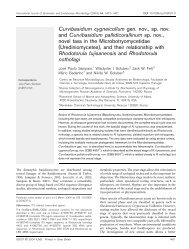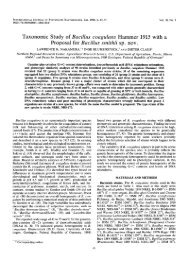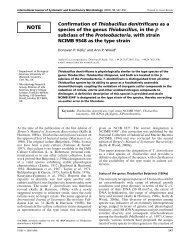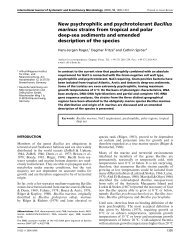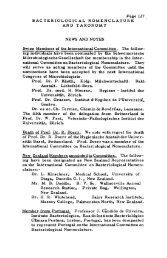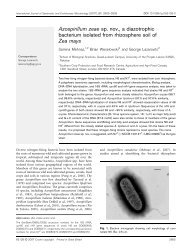Pichia insulana sp. nov., a novel cactophilic yeast from the Caribbean
Pichia insulana sp. nov., a novel cactophilic yeast from the Caribbean
Pichia insulana sp. nov., a novel cactophilic yeast from the Caribbean
Create successful ePaper yourself
Turn your PDF publications into a flip-book with our unique Google optimized e-Paper software.
P. F. Ganter, G. Cardinali and K. Boundy-Mills<br />
several strains <strong>from</strong> <strong>the</strong> <strong>Caribbean</strong> region that had<br />
originally been identified as P. cactophila but did not have<br />
<strong>the</strong> expected partial LSU rDNA sequence, and we added<br />
those strains to this study.<br />
METHODS<br />
Strain isolation and determination of physiological abilities.<br />
Strains used in this study are listed in Table 1. Samples of necrotic<br />
cactus stem tissue were collected <strong>from</strong> five sites on Curaçao in January<br />
2000. Methods for isolation of <strong>yeast</strong> <strong>from</strong> cactus samples have been<br />
described by Starmer & Phaff (1983). Morphological and physiological<br />
tests were done as described by Yarrow (1998), as modified by Lachance<br />
et al. (1988). Over 380 strains were isolated <strong>from</strong> 49 rots and 99 of <strong>the</strong>se<br />
had physiological profiles consistent with P. cactophila. Of those 99<br />
strains, 24 produced four-<strong>sp</strong>ored asci, one produced asci with ei<strong>the</strong>r<br />
two or three <strong>sp</strong>ores and no asci were detected <strong>from</strong> <strong>the</strong> remaining 74<br />
strains. Asci <strong>from</strong> strain TSU00-106.5 T (<strong>the</strong> designated type strain)<br />
were dissected and mating types were determined for all <strong>sp</strong>ore clones.<br />
In addition, matings were attempted between P. <strong>insulana</strong> mating types,<br />
<strong>the</strong> a<strong>sp</strong>orogenous strains of P. <strong>insulana</strong> strains <strong>from</strong> Curaçao, <strong>the</strong> six<br />
strains identified as P. cactophila <strong>from</strong> <strong>the</strong> UC Davis collection and <strong>the</strong><br />
mating types of P. pseudocactophila.<br />
rDNA sequence determination. LSU rDNA sequences were<br />
amplified using primers NL1 and NL4 (Kurtzman & Robnett, 1998)<br />
with <strong>the</strong> following PCR program: 95 uC for 2 min, 36 cycles<br />
consisting of 1 min at 94 uC, 1 min at 52 uC and 2 min at 72 uC<br />
and a final extension of 8 min at 72 uC. After purification with <strong>the</strong> Jet<br />
Quick kit (Genomed GmbH), sequencing was carried out by <strong>the</strong><br />
Table 1. Strain numbers, collection location and host of sequenced P. <strong>insulana</strong> <strong>sp</strong>. <strong>nov</strong>. isolates<br />
MWG service (MWG Biotech AG). Electrophoregrams were read with<br />
TraceViewer (http://www.codoncode.com).<br />
Phylogenetic analysis of <strong>the</strong> sequences. The analysis involved 12<br />
P. <strong>insulana</strong> sequences (Table 1) plus <strong>the</strong> published sequences for <strong>the</strong> type<br />
strains of P. cactophila and o<strong>the</strong>r closely related strains as determined<br />
through rDNA sequence similarity (<strong>from</strong> Kurtzman & Robnett, 1998).<br />
The clade is composed of <strong>cactophilic</strong> <strong>sp</strong>ecies plus <strong>Pichia</strong> kudriavzevii<br />
(formerly Issatchenkia occidentalis; Kurtzmanet al., 2008), <strong>Pichia</strong> nakasei<br />
and Candida incon<strong>sp</strong>icua [<strong>the</strong> sister taxon of P. cactophila in Kurtzman &<br />
Robnett (1998)]. P. nakasei was <strong>the</strong> outgroup for this analysis. There are<br />
now multiple ways to align nucleotide sequences and to construct a<br />
phylogeny based on <strong>the</strong> aligned sequences. Ra<strong>the</strong>r than employ a single<br />
combination of alignment/phylogeny construction algorithms and be<br />
subject to <strong>the</strong> assumptions of both, we chose to employ multiple<br />
alignment/phylogeny construction pairings and to report <strong>the</strong> results<br />
common to all. Sequences were aligned using CLUSTAL_X, DIALIGN 2<br />
(which maximizes <strong>the</strong> number of aligned segments; Morgenstern, 1999)<br />
and SOAP (which uses CLUSTAL_X as its alignment algorithm but varies <strong>the</strong><br />
gap and extension penalties and presents a consensus alignment;<br />
Löytynoja & Milinkovitch, 2001). Phylogenies involving just <strong>the</strong> unique<br />
P. <strong>insulana</strong> sequences plus <strong>the</strong> P. cactophila and C. incon<strong>sp</strong>icua type strain<br />
sequences were constructed using PAUP* (Swofford, 1999) under a variety<br />
of tree comparison criteria, including parsimony (default settings except<br />
that gaps were treated as both missing data and a separate character<br />
state), neighbour-joining and maximum-likelihood (using default PAUP*<br />
settings). Neighbour-joining phylogenies were based on uncorrected p,<br />
F84, Tamura–Nei, Tajima–Nei and maximum-likelihood Jukes–Cantor<br />
distances. A second phylogeny was constructed with <strong>the</strong> addition of 10<br />
more D1/D2 fragment sequences <strong>from</strong> type strains of <strong>sp</strong>ecies in <strong>the</strong> same<br />
clade as P. cactophila (Kurtzman & Robnett, 1998). The increase in<br />
Collections: TSU, first author’s culture collection at Tennessee State University, Nashville, TN, USA; UCD-FST, Phaff Yeast Culture Collection at<br />
<strong>the</strong> University of California, Davis, CA, USA. Yeasts with TSU identification numbers are <strong>from</strong> sites on <strong>the</strong> island of Curaçao, Ne<strong>the</strong>rlands Antilles.<br />
Strains with UCD-FST numbers were originally identified as (possibly) P. cactophila but have LSU rDNA sequences similar to those of P. <strong>insulana</strong>.<br />
Spore data were obtained <strong>from</strong> strains on YM plates inoculated at <strong>the</strong> same time that <strong>the</strong> identification series of plates was inoculated. The search<br />
for <strong>sp</strong>ores was done at or after 5 days post-inoculation.<br />
Strain Location Host* Spores<br />
TSU00-101.1 Weg naar Westpunt Stenocereus griseus Two- and three-<strong>sp</strong>ored asci<br />
TSU00-106.5 T<br />
Weg naar Westpunt Cereus repandus Four-<strong>sp</strong>ored asci<br />
TSU00-115.4 Weg naar Westpunt Stenocereus griseus None<br />
TSU00-125.3 Wacawa Opuntia <strong>sp</strong>. None<br />
TSU00-133.1 Wacawa Opuntia <strong>sp</strong>. None<br />
TSU00-135.2A Wacawa Opuntia <strong>sp</strong>. Four-<strong>sp</strong>ored asci<br />
TSU00-139.4 Savonet Cereus repandus Four-<strong>sp</strong>ored asci<br />
TSU00-142.6 Savonet Stenocereus griseus None<br />
TSU00-144.2 Savonet Stenocereus griseus None<br />
TSU00-149.3 Westpunt Stenocereus griseus None<br />
TSU00-151.3 Westpunt Stenocereus griseus Four-<strong>sp</strong>ored asci<br />
TSU00-153.2A Westpunt Stenocereus griseus None<br />
UCD-FST 81-111 Coastal Venezuela Stenocereus griseus None<br />
UCD-FST 82-472.1 Hi<strong>sp</strong>aniola Pilosocereus <strong>sp</strong>. None<br />
UCD-FST 82-527.3 Hi<strong>sp</strong>aniola Stenocereus hystrix None<br />
UCD-FST 82-608.1 British Virgin Islands Pilosocereus royenii None<br />
UCD-FST 83-1065.2 Cayman Islands Opuntia stricta None<br />
UCD-FST 83-1117.1 Cayman Islands Opuntia stricta fruit None<br />
*Stenocereus griseus5Lemairerocereus griseus; Opuntia <strong>sp</strong>. is probably O. caracassana; Pilosocereus <strong>sp</strong>. is probably P. royenii.<br />
1002 International Journal of Systematic and Evolutionary Microbiology 60



